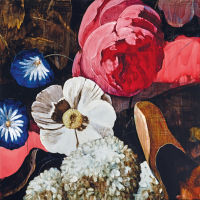36. TIM MAGUIRE

By the time Tim Maguires signature flower paintings were in full flow in the early 1990s, as in this luminous painting Untitled 94 1994, he was well-versed in historical and contemporary art through first-hand museum visits during repeated residencies and travels to Europe and America. International travel had shaped his art practice from the mid-1980s and, it could be said, his life from the start, his parents having returned to Australia from the United Kingdom a year after his birth in 1958. He still divides his life between Australia and France.
The turning point in his early creative development came in late 1984 when, with the assistance of a travelling scholarship through the Australia Council, Maguire was propelled from Sydney to Germany to undertake postgraduate art training at Dsseldorfs renowned Kunstakademie, from the 1960s a hothouse for European avant-garde art practice and future star German artists. It was not his preferred destination, but tuition was free. His tutor, the Dutch conceptual artist Jan Dibbets, encouraged him to visit European art museums and to focus on formal considerations, of gesture, colour, size and the processes of material layering.
By the end of 1988, Maguire had exhibited in London, New York, and in Providence, Rhode Island, and travelled extensively through Europe. All this time during the late 1980s, at home and abroad, Maguire was learning how and what to paint, and to make his imagery less culturally specific, more engaged with the fluid processes of painting. Back in Australia in 1989 with his artist wife Adrienne Gaha, he settled for a time in the Blue Mountains, where he had spent his own childhood, and not coincidently, his historically sourced still-life flower paintings began.
The process of painting these, alongside his other proximate series, one concerned with representations of abstract landscapes and another around light, revealed to Maguire how expanding a figurative detail sourced from a reproduction of a historical still-life painting could produce an abstracted whole and, conversely, how a painting could appear abstract viewed up close while from a distance register as figurative.1 His work therefore achieved a finely honed equipoise between abstraction and representation, melding the art of the past with the present. In 1993 he won the prestigious Mot & Chandon Australian Art Fellowship with the largest flower painting he had done to date and the award took him with his family to a years residency in Hautvillers, in the Champagne region of France.
This large square painting on sized paper, Untitled 94, made shortly after the smaller painting that had won him the fellowship, is similarly endowed with lush painterly effects and compositional assurance, the product of Maguires formative years moving purposefully between the figurative representation of landscape and the painterly structuring of abstraction.
This paintings chiaroscuro of white, red and blue flowers emerging from the shadowy depths of its pictorial space captures the subtle dynamics of meaning and tone of its historical origins in seventeenth-century Dutch and Flemish still-life painting. This traditional genre used the symbolism of vanitas and memento mori to convey that beauty is transient, life is tenuous, and death awaits all. The variegated petals of the translucent white flowers are lyrically but precisely articulated by the painterly flourishes of the artists brushwork; deliberate, descriptive traces of movements, and decisions made during the painting process.
Maguire describes these early flower paintings as being performative, in that they have a beginning and a distinct end determined by the paints fluid transparency.2 This energetic approach to the creative process and materiality of his painting would continue in the late 1990s with further explorations of abstraction derived from life and the act of painting itself.
Footnotes:
1. Jayne, A., An Interview with Tim Maguire, YouTube, uploaded 26 June 2014 [accessed February 2020]: https://vimeo.com/99292042
2. Tim Maguire, quoted in Maguire, T., Godfrey, T. & Watkins, J., Tim Maguire, Piper Press, Sydney, 2018, p.75
Jenepher Duncan
Jenepher Duncan is an independent art consultant. She was previously Curator of Contemporary Australian Art at the Art Gallery of Western Australia, Perth and Director of the Monash University Museum of Art and the Australian Centre for Contemporary Art, Melbourne.